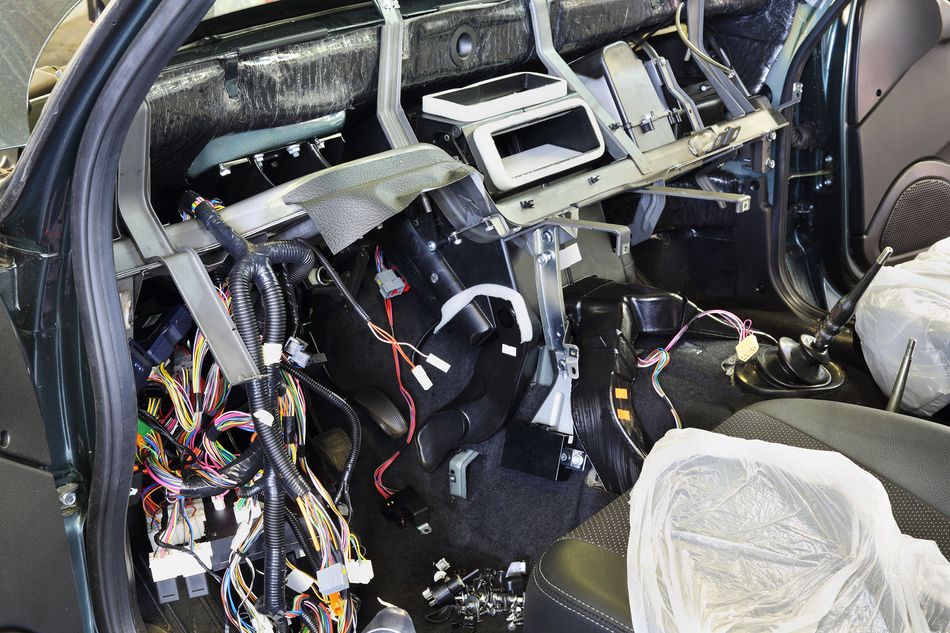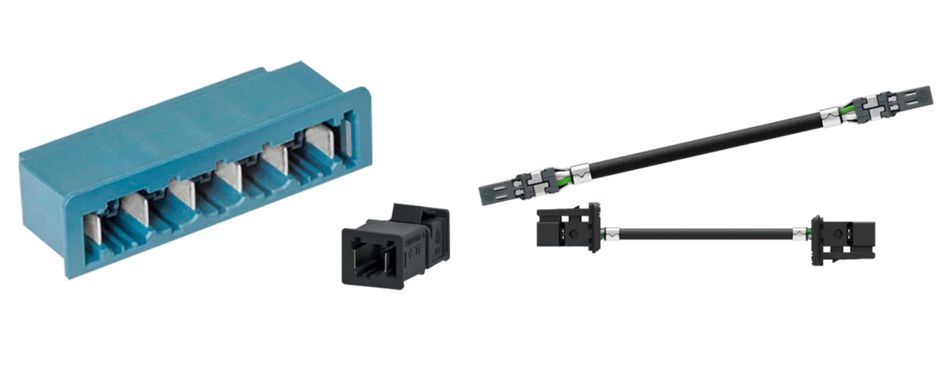Emerging trends and design considerations for automotive connectivity systems in harsh environments
Article #2 of Connectivity and Sensing in Harsh Environments Series: As the bandwidth consumed by vehicular electronics increases, manufacturers need to adopt the latest communication standards, and make various design considerations to ensure signal integrity in harsh environments.
This is the second article in a 6-part series featuring topics on connectivity and sensing in harsh environments. The series will showcase how highly engineered connectivity and sensing solutions enable advancements in manufacturing, transportation, construction, healthcare, energy generation, and consumer products. This series is sponsored by Mouser Electronics. Through the sponsorship, Mouser Electronics shares its passion for technologies that enable smarter and connected applications.
The developments in Advanced Driver Assistance Systems (ADASs), autonomous vehicles, and other cutting-edge vehicular technologies are driving the bandwidth and latency requirements of the communication systems to whole new levels.
Customers are demanding functionalities that automate or enhance operational tasks to increase driver productivity, safety and, in many cases, reduce the total cost of ownership, and operations. Basic customer requirements for vehicles now include automatic braking, adaptive steering, onboard diagnostics, Vehicle-to-Vehicle (V2V) & Vehicle-to-Infrastructure (V2I) communication, and cameras that give drivers a 360-degree view of their environments.
These features require large amounts of data to be transmitted at high speeds and low latency. As engineers design new models to meet these customer demands, the challenge is to ensure signal integrity and proper data transmission.
This article gives an overview of the approach towards how data is transmitted in harsh environments that personal vehicles like cars and commercial vehicles like trucks are put through.
Designing a mixed architecture with Ethernet and CAN bus
Controller Area Network (CAN) bus is a rugged vehicular connectivity architecture that enables controllers and electronic devices to communicate with each other. The protocol supports features like multiplexing to reduce the quantity and cost of electrical wiring in the system. The protocol can typically achieve speeds up to 500 Kbps and has been the stalwart backbone connectivity architecture for most passenger and heavy-duty vehicles for a few decades.
However, the data bandwidth required for advanced vehicle functionality and automated features for safety and productivity is too great to be served by CAN alone. To handle the increased data demands and offer high-speed connectivity, sophisticated network infrastructure is needed.
Upgrading wired vehicular communication with automotive ethernet
Ethernet is the natural first choice of car manufacturers as the technology has stood the test of time. However, ethernet on its own is not enough. It lacks the robustness, and responsiveness that automotive applications demand.
Hence, ethernet standards are revised and special versions are developed to suit specific applications. Automotive ethernet too is developed keeping the automotive application scenario at the center and is quite different from home ethernet. As specified in IEEE 802.3, automotive ethernet is a sub-category of ethernet that includes single Balanced Twisted Pair Ethernet protocols like 100BASE-T1 or 1000BASE-T1 that offer Point-to-Point (P2P) full-duplex data transmission at 100 Mbps and 1 Gbps respectively. [1]
Ethernet networks and connectors allow Original Equipment Manufacturer (OEM) designers to seamlessly integrate more devices into the network and accelerate data connectivity in their vehicles. As a P2P topology, ethernet transforms the vehicle’s electrical and electronic architecture. As Original Equipment Manufacturers (OEMs) decide to add more features and devices, designers will also need to factor in ethernet switches to direct the signal and gateways to enable communication between Ethernet and CAN.
Optimizing the selection and placement of communication links
To optimize space, weight, and performance under harsh conditions, designers must consider how they will integrate ethernet where it is needed in the initial stages of design.
This involves making decisions such as how many cables to place inside the vehicle, where to place them, where to place the ethernet switches, and whether the switch should be in an existing Electronic Control Unit (ECU) or a new dedicated ECU must be made for every feature that requires ethernet. These decisions are crucial to avoid or mitigate Electromagnetic Interference (EMI) and other mechanical disturbances.

Consider for example, the 360-degree cameras on a heavy-duty vehicle transmit high-speed data from outside the vehicle to the in-cabin display for the driver to get a view of his/her surroundings. Four cameras (one on each side of the vehicle) send signals to an ECU. System designers need to plan where to place a switch to combine the data coming from the four cameras and send it in a single signal to the ECU. The switch can be in the vehicle or in one of the cameras, which would have four ports to input data from the three other cameras and then send out data. Another option is to integrate the switch into the video display monitor.
Establishing a future-ready network for vehicular connectivity
Active automated functions such as automatic braking and other ADAS that include a multi-sensor array, require even more thought in early design stages. Each sensor has a dedicated communication link to an ECU. The more sensors the vehicle has, the more cables and connections are needed.
An autonomous heavy-duty vehicle of the future could require a wide sensor array of about 16 Radio Detection And Ranging (RADARs), 10 Light Detection and Ranging (LIDARs), and 10 cameras around the vehicle. That’s more than 30 cables and links that need to be EMI-resistant and smartly routed while considering space, weight, and EMI to maintain signal integrity inside and outside of the chassis, as the links come into one ECU.
Larger commercial vehicles bring more challenges
The immense size of industrial and commercial vehicles presents a challenge in maintaining signal integrity and transmitting data reliably. For sending signals over an ethernet link in cars, the standard specifies a maximum distance of up to 15 meters. [1] But in the case of trucks, buses, and off-highway vehicles, signal integrity must be maintained for longer lengths, going up to 40 meters or more, while withstanding heavy vibration, extreme temperatures, shock, severe dust conditions, and more.
The ethernet standard currently specifies for up to four in-line connections along that 40 meters. Designers need to assess for how long each segment can maintain optimal signal integrity. Factors affecting this could be exposure to outside elements, high temperatures, placement near an antenna, or other components that could cause EMI. Routing is a critical element of design, and the entire physical layer must be scaled for the performance expected.
Choosing the Right Components
When designing a mixed architecture with CAN and ethernet, engineers need to think about the entire connectivity infrastructure upfront in terms of what advanced, data-heavy functions they will be incorporating. The more advanced technology gets, the more collaboration between OEMs and suppliers is important.
Along with a wide range of components, product specialists and design engineers from brands like TE Connectivity offer solutions and consultancy in product development for partners to ensure maximum optimization and longevity in designs.
Abas Alwishah, Data Connectivity Engineering Manager from TE Connectivity explains:
"Suppose a customer tells me they need a high-definition camera or proximity detection system that works with very low latency. In that case, I can explain all the individual components needed to implement that functionality or system. By sharing the details about sensors, connectors, cable assemblies, antennas, processors, display, etc., recommendations on the topology to optimize performance, space, weight, and costs can be provided.”
Choosing ethernet-compatible components that can withstand harsh conditions is key to reliable data transmission in long-lifetime, heavy-duty vehicles. Automotive ethernet connectors (those designed originally for passenger vehicles) can be used in the cabin or other areas of the vehicle not exposed to extreme shock, temperature, or other elements, where more ruggedized connectors and longer-length cables are not needed. A high-quality unshielded twisted-pair cable is suitable for ethernet in most areas of the vehicle, with shielded twisted-pair cables used only where necessary. The designer’s choices also will help control costs and save space and weight.
Modular and scalable Miniaturized Automotive Ethernet (MATEnet) connectors for automotive Ethernet, for example, can be used in heavy-duty vehicles for applications requiring mid to large-size data volumes and low latencies, such as onboard diagnostics, Vehicle-to-Everything (V2X) technologies, telematics, dashboard infotainment, ADAS, and more. The connectors can transmit data at 100 Mbps to 1 Gbps (as per IEEE 100BASE-T1/1000BASE-T1 standards) and can be used with unshielded or shielded twisted-pair cables.
On-chassis components require more than just ruggedness. They must demonstrate mechanical reliability, be serviceable, be able to withstand extreme temperatures, and operate efficiently with longer channel lengths. When dealing with higher frequencies, cable/connector quality and design can significantly impact channel performance, which ultimately affects application performance. Especially for on-chassis components, engineers need to opt for cables and connectors specifically designed for high-speed data transmission in harsh environments.
“When trying to meet mechanical resilience needs, some engineers may instinctively think to add a larger, more robust housing, but thicker walls may negatively impact electrical performance. It’s important to look at what historically has worked, but also to take a further step to understand this new generation of electrical needs for transmitting high-speed data and test how connections will perform given the higher frequencies involved.”
-Mark Brubaker, Data Connectivity Product Manager, TE Connectivity
Conclusion
Product choice and placement cannot be an afterthought when designing advanced and automated functionality that requires high-speed data transmission. When adding ethernet to heavy-duty vehicle architectures, designers must think about and plan for the complexities involved much earlier and deeper than ever before. This is the only way to successfully balance reliability and mechanical resilience with electrical requirements for high-speed data, longer channel lengths, and serviceability needs.
This article was initially published by Mouser and Amphenol in an e-magazine. It has been substantially edited by the Wevolver team and Electrical Engineer Ravi Y Rao. It's the second article of a 6-part series examining connectivity and sensing technologies for harsh environments. Future articles will introduce readers to some more interesting applications of the technology in various industries.
- The introductory article provided an overview of the different harsh environments that electronic circuits and systems are put through.
- The first article showcased how improvements in connectors, terminals, splices, relays, and heat shrink tubing enable connected applications
- The second article was focused on some key trends and design considerations for automotive connectivity systems.
- The third article presented three case studies on how connectors and terminals enable massive power handling in offshore installations.
- The fourth article shifted the focus back to the transport industry to explain the necessity of reliable connectors that withstand harsh environments.
- The fifth article was about the theory of sensor design for harsh environments.
- The final article examined the principles, design, manufacturing, and applications of heat shrink cable accessories in depth.
About the sponsor: Mouser Electronics
Mouser Electronics is a worldwide leading authorized distributor of semiconductors and electronic components for over 1,100 manufacturer brands. They specialize in the rapid introduction of new products and technologies for design engineers and buyers. Their extensive product offering includes semiconductors, interconnects, passives, and electromechanical components.

References
[1] "IEEE Standard for Ethernet Amendment 1: Physical Layer Specifications and Management Parameters for 100 Mb/s Operation over a Single Balanced Twisted Pair Cable (100BASE-T1)," in IEEE Std 802.3bw-2015 (Amendment to IEEE Std 802.3-2015, vol., no., pp.1-88, 7 March 2016, doi: 10.1109/IEEESTD.2016.7433918.
[2] Anne Nentwig, ‘Automotive Connector Strategies and Solutions for Space Savings’, August 2018, [Online], Available from: https://www.te.com/usa-en/industries/automotive/insights/miniaturization-wp.html


